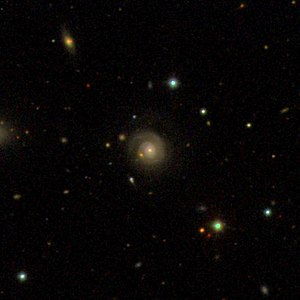IC 3078
| IC 3078 | |
|---|---|
 IC 3078 captured by Sloan Digital Sky Survey | |
| Observation data (J2000 epoch) | |
| Constellation | Virgo |
| Right ascension | 12h 16m 00.044s |
| Declination | +12° 41′ 14.31″ |
| Redshift | 0.066148 |
| Helio radial velocity | 19,829 km/s |
| Distance | 905 Mly (277.4 Mpc) |
| Apparent magnitude (V) | 14.5 |
| Apparent magnitude (B) | 15.3 |
| Characteristics | |
| Type | Sb(r) I, Sy1.9 |
| Apparent size (V) | 0.50′ × 0.5′ |
| Notable features | Starburst galaxy, seyfert galaxy |
| Other designations | |
| IRAS F12134+1257, IC 3078, MCG+02-31-073, PGC 39263 | |
IC 3078 is a spiral galaxy with a ring structure[1] located in Virgo. Its redshift is 0.066148,[2] meaning IC 3078 is located 905 million light-years from Earth.[3] With an apparent dimension of 0.50 x 0.5 arcmin, IC 3038 is about 133,000 light-years across.[4] It was discovered by Royal Harwood Frost on May 7, 1904[5][6] and is listed in the Virgo Cluster catalogue as VCC 174. However, it is not a member of the Virgo Cluster, but instead a background galaxy.[7]
Features[edit]
The nucleus of IC 3078 is found to be active. It is a Seyfert galaxy of type 1.9[3] and classified a Markarian galaxy (designated Mrk 764), because compared to other galaxies its nucleus emits excessive amounts of ultraviolet rays.[8] More IC 3078 is a starburst galaxy since a study published in 1983, mentions it displays a bright star-like nucleus. However, it does not display broad-line emission spectra which is the characteristic of Seyfert galaxies.[9] Instead its features can be explained through the presence of the population of hot, young stars. IC 3078 is known to be a star-burst nuclei, in which the phenomenon might supply enough material for gravitational accretion, hence the development of active galaxies.[9]
According to a further study done by Hideaki and Yoshiaki, it is proven IC 3078 is classified an old starburst galaxy, which is deficient in O-type stars and does not exhibit strong line emission. But however, IC 3078 still has many B stars which is expected to heat up dust grains and generate strong continuum emission in far-infrared areas.[10] Furthermore, IC 3078 lies in the ~9033 square degrees of the sky which is observed by the VLA FIRST survey radio catalogue. From the results, a positive detection of radio emission is found, IC 3078 included, in 775 AGN of which 214 of them show new detections at radio wavelengths.[11]
Moreover, IC 3078 has been observed by IRAS for its optically selected starburst nuclei to derived its far-infrared luminosity and through tabulating its distance and blue and Hα luminosity, written by Deutsch and Willner.[12] It was also one of the galaxies to be studied by Kiso Survey for ultraviolet-excess, which was detected on multi-color plates by the Kiso Schmidt telescope for 10 survey fields and catalogued down to a magnitude of 18.[13]
In a study conducted in 1995, which radio data is presented for IC 3078 and 898 other Markarian galaxies which was observed at v=4.755 GHz through the NRAO-Green Bank 300 foot (91m) telescope, scientists found that detection rates increased to (49%, 33%) amongst seyferts and to (73%, 42%) for those with starburst nuclei.[14] From the study, it is found that IC 3078 has a radio luminosity of h^2^P_1.415_ < 10^23^ W Hz^-1^, a characteristic of normal galaxies.[14]
References[edit]
- ↑ "HyperLeda -object description". atlas.obs-hp.fr. Retrieved 2024-05-14.
- ↑ "IC 3078 - galaxy. Description IC 3078". kosmoved.ru. Retrieved 2024-05-14.
- ↑ 3.0 3.1 "Your NED Search Results". ned.ipac.caltech.edu. Retrieved 2024-05-14.
- ↑ "Revised IC Data for IC 3078". spider.seds.org. Retrieved 2024-05-14.
- ↑ "Index Catalog Objects: IC 3050 - 3099". cseligman.com. Retrieved 2024-05-14.
- ↑ "List of NGC/IC observers". www.klima-luft.de. Retrieved 2024-05-14.
- ↑ Binggeli, B.; Sandage, A.; Tammann, G. A. (1985-09-01). "Studies of the Virgo cluster. II. A catalog of 2096 galaxies in the Virgo cluster area". The Astronomical Journal. 90: 1681–1758. Bibcode:1985AJ.....90.1681B. doi:10.1086/113874. ISSN 0004-6256.
- ↑ Mazzarella, Joseph M.; Balzano, Vicki A. (1986-12-01). "A Catalog of Markarian Galaxies". The Astrophysical Journal Supplement Series. 62: 751. Bibcode:1986ApJS...62..751M. doi:10.1086/191155. ISSN 0067-0049.
- ↑ 9.0 9.1 Balzano, V. A. (1983-05-01). "Star-burst galactic nuclei". The Astrophysical Journal. 268: 602–627. Bibcode:1983ApJ...268..602B. doi:10.1086/160983. ISSN 0004-637X.
- ↑ Mouri, Hideaki; Taniguchi, Yoshiaki (2000-12-01). "Numerous Old Starburst Galaxies in the Local Universe". The Astrophysical Journal. 545 (2): L103–L106. arXiv:astro-ph/0009454. Bibcode:2000ApJ...545L.103M. doi:10.1086/317883. ISSN 0004-637X.
- ↑ Wadadekar, Y. (2004-03-01). "Radio emission from AGN detected by the VLA FIRST survey". Astronomy and Astrophysics. 416: 35–40. arXiv:astro-ph/0405359. Bibcode:2004A&A...416...35W. doi:10.1051/0004-6361:20034244. ISSN 0004-6361.
- ↑ Deutsch, L. K.; Willner, S. P. (1987-04-01). "Far-Infrared Luminosities of Markarian Starburst Galaxies. II. Individual Galaxies". The Astrophysical Journal Supplement Series. 63: 803. Bibcode:1987ApJS...63..803D. doi:10.1086/191183. ISSN 0067-0049.
- ↑ Takase, Bunshiro; Miyauchi-Isobe, Nagako (1989-01-01). "Kiso survey for ultraviolet-excess galaxies. IX". Publications of the National Astronomical Observatory of Japan. 1: 11–42. Bibcode:1989PNAOJ...1...11T. ISSN 0915-3640.
- ↑ 14.0 14.1 Bicay, M. D.; Kojoian, G.; Seal, J.; Dickinson, D. F.; Malkan, M. A. (1995-06-01). "A Multifrequency Radio Continuum and IRAS Faint Source Survey of Markarian Galaxies". The Astrophysical Journal Supplement Series. 98: 369. Bibcode:1995ApJS...98..369B. doi:10.1086/192168. ISSN 0067-0049.
This article "IC 3078" is from Wikipedia. The list of its authors can be seen in its historical and/or the page Edithistory:IC 3078. Articles copied from Draft Namespace on Wikipedia could be seen on the Draft Namespace of Wikipedia and not main one.
